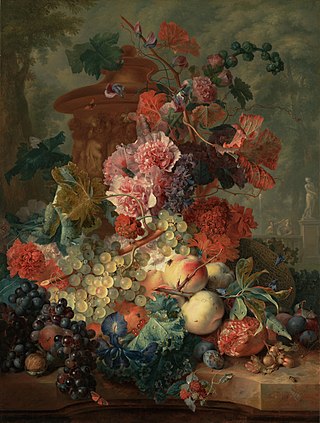
Jan van Huysum is the most notable member of the Van Huysum family of artists working in Dutch Golden Age of the 17th and 18th centuries; “by common consent, Jan van Huysum has been held to be the best painter of flowers.” Trained in decoration from a young age, he “gradually developed an execution of details of the utmost beauty and finish” creating “wonderful flower pieces whereon drops of water and crawling ants could be seen without a magnifying glass.”

Abraham Mignon or Minjon, was a still life painter. He is known for his flower pieces, still lifes with fruit, still lifes in forests or grottoes, still lifes of game and fish as well as his garland paintings. His works are influenced by those of Jan Davidszoon de Heem and Jacob Marrel.

Rachel Ruysch was a Dutch still-life painter from the Northern Netherlands. She specialized in flowers, inventing her own style and achieving international fame in her lifetime. Due to a long and successful career that spanned over six decades, she became the best documented woman painter of the Dutch Golden Age.

Maria van Oosterwijck, also spelled Oosterwyck, (1630–1693) was a Dutch Golden Age painter, specializing in richly detailed flower paintings and other still lifes.
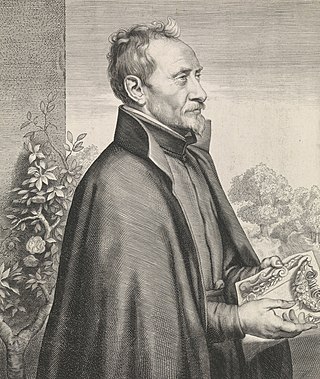
Daniël Seghers or Daniel Seghers was a Flemish Jesuit brother and painter who specialized in flower still lifes. He is particularly well known for his contributions to the genre of flower garland painting. His paintings were collected enthusiastically by aristocratic patrons and he had numerous followers and imitators.

Albertus Jonas Brandt was a Dutch still life painter. He was the son of a book printer and seller. While working in his father's shop, he became a pupil of J. E. Morel. After Morel's death in 1808, he spent two years with the painter G. J. J. van Os,. When van Os moved to France in 1810, Brandt taught himself, copying Jan van Huysum. In 1814 and 1816 he won prizes in the academy Felix Meritis. Soon he became famous, painting dead game, fruit, and flowers.
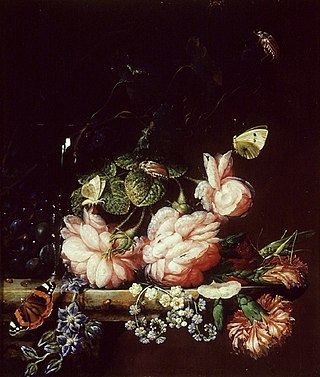
Ottmar Elliger (1633–1679) was a Flemish Baroque flower painter.

Justus van Huysum, also spelled Huijsum, was a Dutch Golden Age painter.

Jan Frans van Dael or Jean-François van Dael was a Flemish painter and lithographer specializing in still lifes of flowers and fruit. He had a successful career in Paris where his patrons included the Empresses of Empire France as well as the kings of Restoration France. His work stands in the Flemish and Dutch tradition of flower painting with a sober composition and attention to detail to which he added a French-inspired decorative monumentality.

Pronkstilleven is a style of ornate still life painting, which was developed in the 1640s in Antwerp from where it spread quickly to the Dutch Republic.

Anna Ruysch was a Dutch Golden Age flower painter.
Francina Margaretha van Huysum (1707–1789), was a Dutch 18th-century flower painter from the Northern Netherlands.
Margaretha Haverman was an 18th-century flower painter from the Northern Netherlands.
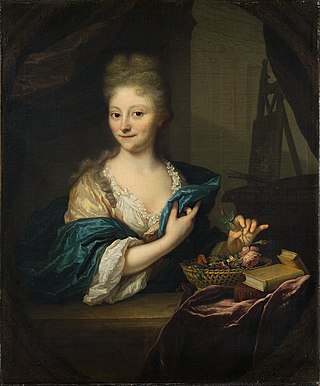
Catharina Backer was an art collector and an 18th-century painter from the Northern Netherlands.
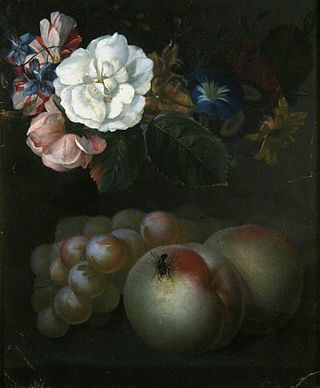
Agatha van der Mijn, was an 18th-century flower painter from the Northern Netherlands active in London.

Roses, Convolvulus, Poppies and Other Flowers in an Urn on a Stone Ledge (1688) is an oil on canvas painting by the Dutch painter Rachel Ruysch. It is an example of Dutch Golden Age painting and is now in the collection of the National Museum of Women in the Arts.

Still life with flowers on a marble slab is a 1716 floral painting by Rachel Ruysch. It is in the collection of the Rijksmuseum, in Amsterdam.

Flowers in a Wan-Li Vase is a c. 1620s floral painting by Balthasar van der Ast in the collection of the Suermondt-Ludwig-Museum.

Van Huysum is a surname from the Netherlands, meaning "of/from Huizum," a district of Leiden, South Holland.
























